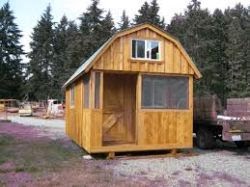An appropriately designed shed in your backyard can greatly improve the look and feel of your garden and your home ( official website ). A shed can be completely built in a matter of some days with the proper shed blueprints and some planning. It is necessary to take your time and pick the correct shed blueprints to best suit your requirements because there are a large number of shed designs available. How are you going to use this shed and where are you going to place? Ask yourself this when you are choosing your shed design. Also pick the shed design such that it blends in easily into the background landscape. Make sure that the blueprints have enough details so that even an inexperienced handyman would be able to finish the project without having any doubts at any point during construction of the shed.
Some types of timber may be more costly in certain regions if they are not native to that area, so it may be a good idea to stick to locally available timber ( yard shed drafting schematics ). Timber increases in weather resistance after pressure treatment, so use pressure treated lumber as much as possible. If you can afford a finer and more costly brand of wood then pick the grain of the wood keeping in mind if you want to paint your shed or use a clear coat of varnish. If you will be using a transparent emulsion on your shed then you should definitely go for lumber with a good grain.
Pick the best type of wood available at the wood yard keeping in mind your budget and the durability of the kind of lumber you are selecting. A good strategy may be to use stronger wood for constructing the vital parts of your shed like beams, rafters and foundation. Then use a bit lesser quality wood for the less critical parts and sections which will be less exposed to weather. Using this strategy you will be able to keep expenses low while still maintain the durability of the shed.
You must have a clear picture of the purpose of the shed before you start looking for the plans for constructing the shed. Would you be using you shed for storing tools or will it be used as a potting shed? Perhaps you would like to store you tractor or maybe even your car in it. You can convert it into an extra bedroom or just turn it into a playhouse for the kids. after you have finalized how you will be using the shed, it will not be difficult to select the best shed design and size. If you want to use your shed for human habitation you may want to make arrangements for electrical fittings for lights and cooling and even plumbing.
Ensure that you leave enough space for framing the doors and windows so that you can get plenty of sunlight and air. If you plan on storing large items in your shed like a lawn mower or a tractor make sure the doors are wide enough for the things to be easily moved in and out of the shed. Don't forget to leave some extra space within your shed during the planning which will come in handy in the future as you need for space increases. Larger sheds will need approval from your local constructing department so make sure you fill out all the necessary forms beforehand. Before you start construction make sure you discuss with the local constructing council.
The materials used in the construction of the shed should be selected carefully. Certain types of lumber are better for shed construction compared to others. Just selecting the cheapest type of wood available at your local lumberyard is not a good idea. Many times your shed blueprints themselves mention the most preferable types of wood. When constructing outdoor structures like sheds it is crucial to use a weather resistant and rot resistant kind of wood.
You will need to put very little efforts for maintaining your shed year after year ( board and batten wood shed designing diagrams ). Cedar is one such kind of wood. Redwood is another such rot resistant variety of wood and so is pine. However, on the downside you will need to spend more for acquiring such kind of fine quality timber. Some other durable varieties of lumber include oak, walnut, chestnut, mulberry and catalpa.
